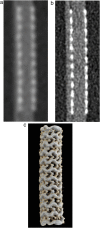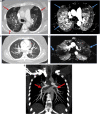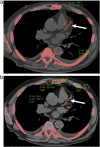Dual energy imaging in cardiothoracic pathologies: A primer for radiologists and clinicians
- PMID: 33532519
- PMCID: PMC7822965
- DOI: 10.1016/j.ejro.2021.100324
Dual energy imaging in cardiothoracic pathologies: A primer for radiologists and clinicians
Abstract
Recent advances in dual-energy imaging techniques, dual-energy subtraction radiography (DESR) and dual-energy CT (DECT), offer new and useful additional information to conventional imaging, thus improving assessment of cardiothoracic abnormalities. DESR facilitates detection and characterization of pulmonary nodules. Other advantages of DESR include better depiction of pleural, lung parenchymal, airway and chest wall abnormalities, detection of foreign bodies and indwelling devices, improved visualization of cardiac and coronary artery calcifications helping in risk stratification of coronary artery disease, and diagnosing conditions like constrictive pericarditis and valvular stenosis. Commercially available DECT approaches are classified into emission based (dual rotation/spin, dual source, rapid kilovoltage switching and split beam) and detector-based (dual layer) systems. DECT provide several specialized image reconstructions. Virtual non-contrast images (VNC) allow for radiation dose reduction by obviating need for true non contrast images, low energy virtual mono-energetic images (VMI) boost contrast enhancement and help in salvaging otherwise non-diagnostic vascular studies, high energy VMI reduce beam hardening artifacts from metallic hardware or dense contrast material, and iodine density images allow quantitative and qualitative assessment of enhancement/iodine distribution. The large amount of data generated by DECT can affect interpreting physician efficiency but also limit clinical adoption of the technology. Optimization of the existing workflow and streamlining the integration between post-processing software and picture archiving and communication system (PACS) is therefore warranted.
Keywords: AI, artificial intelligence; BT, blalock-taussig; CAD, computer-aided detection; CR, computed radiography; DECT, dual-energy computed tomography; DESR, dual-energy subtraction radiography; Dual energy CT; Dual energy radiography; NIH, national institute of health; NPV, negative predictive value; PACS, picture archiving and communication system; PCD, photon-counting detector; PET, positron emission tomography; PPV, positive predictive value; Photoelectric effect; SNR, signal to noise ratio; SPECT, single photon emission computed tomography; SVC, superior vena cava; TAVI, transcatheter aortic valve implantation; TNC, true non contrast; VMI, virtual mono-energetic images; VNC, virtual non-contrast images; eGFR, estimated glomerular filtration rate; kV, kilo volt; keV, kilo electron volt.
© 2021 The Authors.
Conflict of interest statement
The author(s) or author(s) institutions have no conflicts of interest pertaining to this project.
Figures




















References
-
- Takai M., Kaneko M. Discrimination between thorotrast and iodine contrast medium by means of dual-energy CT scanning. Phys. Med. Biol. 1984;29(8):959–967. - PubMed
-
- Kelcz F., Joseph P.M., Hilal S.K. Noise considerations in dual energy CT scanning. Med. Phys. 1979;6(5):418–425. - PubMed
-
- Yao Y., Ng J.M., Megibow A.J., Pelc N.J. Image quality comparison between single energy and dual energy CT protocols for hepatic imaging. Med. Phys. 2016;43(8):4877. - PubMed
-
- Heye T., Nelson R.C., Ho L.M., Marin D., Boll D.T. Dual-energy CT applications in the abdomen. AJR Am. J. Roentgenol. 2012;199(5 Suppl):S64–70. - PubMed
Publication types
LinkOut - more resources
Full Text Sources
Other Literature Sources
Research Materials
Miscellaneous

